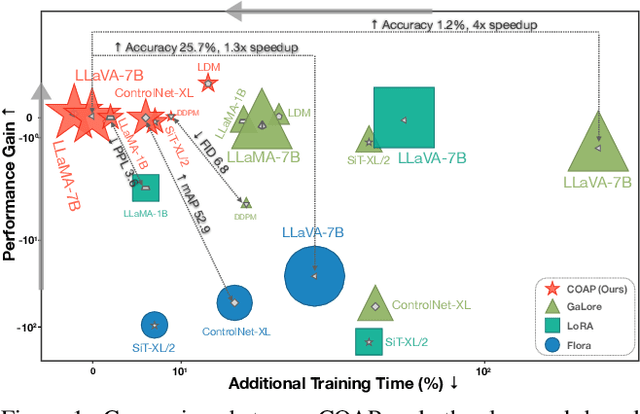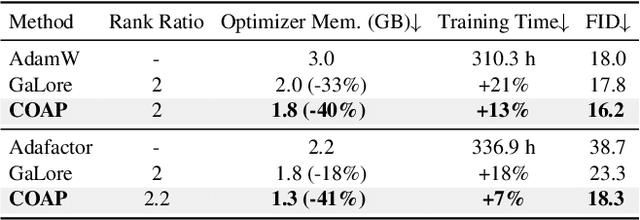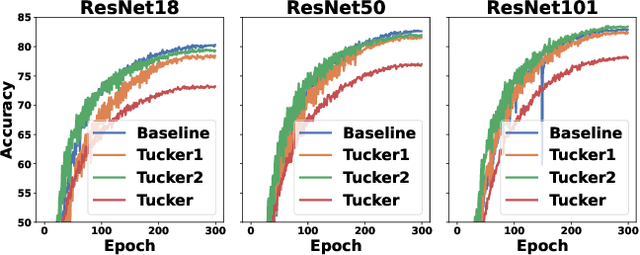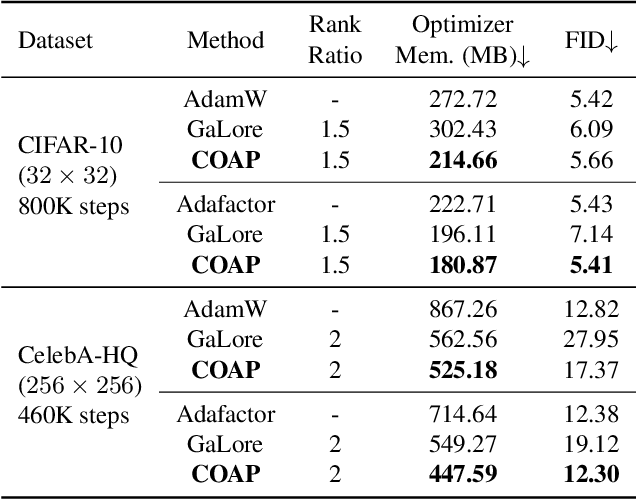Bo Yuan
InstructMoLE: Instruction-Guided Mixture of Low-rank Experts for Multi-Conditional Image Generation
Dec 25, 2025Abstract:Parameter-Efficient Fine-Tuning of Diffusion Transformers (DiTs) for diverse, multi-conditional tasks often suffers from task interference when using monolithic adapters like LoRA. The Mixture of Low-rank Experts (MoLE) architecture offers a modular solution, but its potential is usually limited by routing policies that operate at a token level. Such local routing can conflict with the global nature of user instructions, leading to artifacts like spatial fragmentation and semantic drift in complex image generation tasks. To address these limitations, we introduce InstructMoLE, a novel framework that employs an Instruction-Guided Mixture of Low-Rank Experts. Instead of per-token routing, InstructMoLE utilizes a global routing signal, Instruction-Guided Routing (IGR), derived from the user's comprehensive instruction. This ensures that a single, coherently chosen expert council is applied uniformly across all input tokens, preserving the global semantics and structural integrity of the generation process. To complement this, we introduce an output-space orthogonality loss, which promotes expert functional diversity and mitigates representational collapse. Extensive experiments demonstrate that InstructMoLE significantly outperforms existing LoRA adapters and MoLE variants across challenging multi-conditional generation benchmarks. Our work presents a robust and generalizable framework for instruction-driven fine-tuning of generative models, enabling superior compositional control and fidelity to user intent.
EcoSpa: Efficient Transformer Training with Coupled Sparsity
Nov 09, 2025Abstract:Transformers have become the backbone of modern AI, yet their high computational demands pose critical system challenges. While sparse training offers efficiency gains, existing methods fail to preserve critical structural relationships between weight matrices that interact multiplicatively in attention and feed-forward layers. This oversight leads to performance degradation at high sparsity levels. We introduce EcoSpa, an efficient structured sparse training method that jointly evaluates and sparsifies coupled weight matrix pairs, preserving their interaction patterns through aligned row/column removal. EcoSpa introduces a new granularity for calibrating structural component importance and performs coupled estimation and sparsification across both pre-training and fine-tuning scenarios. Evaluations demonstrate substantial improvements: EcoSpa enables efficient training of LLaMA-1B with 50\% memory reduction and 21\% faster training, achieves $2.2\times$ model compression on GPT-2-Medium with $2.4$ lower perplexity, and delivers $1.6\times$ inference speedup. The approach uses standard PyTorch operations, requiring no custom hardware or kernels, making efficient transformer training accessible on commodity hardware.
GhostShell: Streaming LLM Function Calls for Concurrent Embodied Programming
Aug 07, 2025



Abstract:We present GhostShell, a novel approach that leverages Large Language Models (LLMs) to enable streaming and concurrent behavioral programming for embodied systems. In contrast to conventional methods that rely on pre-scheduled action sequences or behavior trees, GhostShell drives embodied systems to act on-the-fly by issuing function calls incrementally as tokens are streamed from the LLM. GhostShell features a streaming XML function token parser, a dynamic function interface mapper, and a multi-channel scheduler that orchestrates intra-channel synchronous and inter-channel asynchronous function calls, thereby coordinating serial-parallel embodied actions across multiple robotic components as directed by the LLM. We evaluate GhostShell on our robot prototype COCO through comprehensive grounded experiments across 34 real-world interaction tasks and multiple LLMs. The results demonstrate that our approach achieves state-of-the-art Behavioral Correctness Metric of 0.85 with Claude-4 Sonnet and up to 66X faster response times compared to LLM native function calling APIs. GhostShell also proves effective in long-horizon multimodal tasks, demonstrating strong robustness and generalization.
Label Distribution Learning-Enhanced Dual-KNN for Text Classification
Mar 06, 2025



Abstract:Many text classification methods usually introduce external information (e.g., label descriptions and knowledge bases) to improve the classification performance. Compared to external information, some internal information generated by the model itself during training, like text embeddings and predicted label probability distributions, are exploited poorly when predicting the outcomes of some texts. In this paper, we focus on leveraging this internal information, proposing a dual $k$ nearest neighbor (D$k$NN) framework with two $k$NN modules, to retrieve several neighbors from the training set and augment the distribution of labels. For the $k$NN module, it is easily confused and may cause incorrect predictions when retrieving some nearest neighbors from noisy datasets (datasets with labeling errors) or similar datasets (datasets with similar labels). To address this issue, we also introduce a label distribution learning module that can learn label similarity, and generate a better label distribution to help models distinguish texts more effectively. This module eases model overfitting and improves final classification performance, hence enhancing the quality of the retrieved neighbors by $k$NN modules during inference. Extensive experiments on the benchmark datasets verify the effectiveness of our method.
HeadInfer: Memory-Efficient LLM Inference by Head-wise Offloading
Feb 18, 2025



Abstract:Transformer-based large language models (LLMs) demonstrate impressive performance in long context generation. Extending the context length has disproportionately shifted the memory footprint of LLMs during inference to the key-value cache (KV cache). In this paper, we propose HEADINFER, which offloads the KV cache to CPU RAM while avoiding the need to fully store the KV cache for any transformer layer on the GPU. HEADINFER employs a fine-grained, head-wise offloading strategy, maintaining only selective attention heads KV cache on the GPU while computing attention output dynamically. Through roofline analysis, we demonstrate that HEADINFER maintains computational efficiency while significantly reducing memory footprint. We evaluate HEADINFER on the Llama-3-8B model with a 1-million-token sequence, reducing the GPU memory footprint of the KV cache from 128 GB to 1 GB and the total GPU memory usage from 207 GB to 17 GB, achieving a 92% reduction compared to BF16 baseline inference. Notably, HEADINFER enables 4-million-token inference with an 8B model on a single consumer GPU with 24GB memory (e.g., NVIDIA RTX 4090) without approximation methods.
Survey and Improvement Strategies for Gene Prioritization with Large Language Models
Jan 30, 2025


Abstract:Rare diseases are challenging to diagnose due to limited patient data and genetic diversity. Despite advances in variant prioritization, many cases remain undiagnosed. While large language models (LLMs) have performed well in medical exams, their effectiveness in diagnosing rare genetic diseases has not been assessed. To identify causal genes, we benchmarked various LLMs for gene prioritization. Using multi-agent and Human Phenotype Ontology (HPO) classification, we categorized patients based on phenotypes and solvability levels. As gene set size increased, LLM performance deteriorated, so we used a divide-and-conquer strategy to break the task into smaller subsets. At baseline, GPT-4 outperformed other LLMs, achieving near 30% accuracy in ranking causal genes correctly. The multi-agent and HPO approaches helped distinguish confidently solved cases from challenging ones, highlighting the importance of known gene-phenotype associations and phenotype specificity. We found that cases with specific phenotypes or clear associations were more accurately solved. However, we observed biases toward well-studied genes and input order sensitivity, which hindered gene prioritization. Our divide-and-conquer strategy improved accuracy by overcoming these biases. By utilizing HPO classification, novel multi-agent techniques, and our LLM strategy, we improved causal gene identification accuracy compared to our baseline evaluation. This approach streamlines rare disease diagnosis, facilitates reanalysis of unsolved cases, and accelerates gene discovery, supporting the development of targeted diagnostics and therapies.
PLPP: Prompt Learning with Perplexity Is Self-Distillation for Vision-Language Models
Dec 18, 2024Abstract:Pre-trained Vision-Language (VL) models such as CLIP have demonstrated their excellent performance across numerous downstream tasks. A recent method, Context Optimization (CoOp), further improves the performance of VL models on downstream tasks by introducing prompt learning. CoOp optimizes a set of learnable vectors, aka prompt, and freezes the whole CLIP model. However, relying solely on CLIP loss to fine-tune prompts can lead to models that are prone to overfitting on downstream task. To address this issue, we propose a plug-in prompt-regularization method called PLPP (Prompt Learning with PerPlexity), which use perplexity loss to regularize prompt learning. PLPP designs a two-step operation to compute the perplexity for prompts: (a) calculating cosine similarity between the weight of the embedding layer and prompts to get labels, (b) introducing a language model (LM) head that requires no training behind text encoder to output word probability distribution. Meanwhile, we unveil that the essence of PLPP is inherently a form of self-distillation. To further prevent overfitting as well as to reduce the additional computation introduced by PLPP, we turn the hard label to soft label and choose top-$k$ values for calculating the perplexity loss. For accelerating model convergence, we introduce mutual self-distillation learning, that is perplexity and inverted perplexity loss. The experiments conducted on four classification tasks indicate that PLPP exhibits superior performance compared to existing methods.
COAP: Memory-Efficient Training with Correlation-Aware Gradient Projection
Nov 26, 2024



Abstract:Training large-scale neural networks in vision, and multimodal domains demands substantial memory resources, primarily due to the storage of optimizer states. While LoRA, a popular parameter-efficient method, reduces memory usage, it often suffers from suboptimal performance due to the constraints of low-rank updates. Low-rank gradient projection methods (e.g., GaLore, Flora) reduce optimizer memory by projecting gradients and moment estimates into low-rank spaces via singular value decomposition or random projection. However, they fail to account for inter-projection correlation, causing performance degradation, and their projection strategies often incur high computational costs. In this paper, we present COAP (Correlation-Aware Gradient Projection), a memory-efficient method that minimizes computational overhead while maintaining training performance. Evaluated across various vision, language, and multimodal tasks, COAP outperforms existing methods in both training speed and model performance. For LLaMA-1B, it reduces optimizer memory by 61% with only 2% additional time cost, achieving the same PPL as AdamW. With 8-bit quantization, COAP cuts optimizer memory by 81% and achieves 4x speedup over GaLore for LLaVA-v1.5-7B fine-tuning, while delivering higher accuracy.
Reconciling Semantic Controllability and Diversity for Remote Sensing Image Synthesis with Hybrid Semantic Embedding
Nov 22, 2024



Abstract:Significant advancements have been made in semantic image synthesis in remote sensing. However, existing methods still face formidable challenges in balancing semantic controllability and diversity. In this paper, we present a Hybrid Semantic Embedding Guided Generative Adversarial Network (HySEGGAN) for controllable and efficient remote sensing image synthesis. Specifically, HySEGGAN leverages hierarchical information from a single source. Motivated by feature description, we propose a hybrid semantic Embedding method, that coordinates fine-grained local semantic layouts to characterize the geometric structure of remote sensing objects without extra information. Besides, a Semantic Refinement Network (SRN) is introduced, incorporating a novel loss function to ensure fine-grained semantic feedback. The proposed approach mitigates semantic confusion and prevents geometric pattern collapse. Experimental results indicate that the method strikes an excellent balance between semantic controllability and diversity. Furthermore, HySEGGAN significantly improves the quality of synthesized images and achieves state-of-the-art performance as a data augmentation technique across multiple datasets for downstream tasks.
Exploring Accuracy-Fairness Trade-off in Large Language Models
Nov 21, 2024



Abstract:Large Language Models (LLMs) have made significant strides in the field of artificial intelligence, showcasing their ability to interact with humans and influence human cognition through information dissemination. However, recent studies have brought to light instances of bias inherent within these LLMs, presenting a critical issue that demands attention. In our research, we delve deeper into the intricate challenge of harmonising accuracy and fairness in the enhancement of LLMs. While improving accuracy can indeed enhance overall LLM performance, it often occurs at the expense of fairness. Overemphasising optimisation of one metric invariably leads to a significant degradation of the other. This underscores the necessity of taking into account multiple considerations during the design and optimisation phases of LLMs. Therefore, we advocate for reformulating the LLM training process as a multi-objective learning task. Our investigation reveals that multi-objective evolutionary learning (MOEL) methodologies offer promising avenues for tackling this challenge. Our MOEL framework enables the simultaneous optimisation of both accuracy and fairness metrics, resulting in a Pareto-optimal set of LLMs. In summary, our study sheds valuable lights on the delicate equilibrium between accuracy and fairness within LLMs, which is increasingly significant for their real-world applications. By harnessing MOEL, we present a promising pathway towards fairer and more efficacious AI technologies.
 Add to Chrome
Add to Chrome Add to Firefox
Add to Firefox Add to Edge
Add to Edge